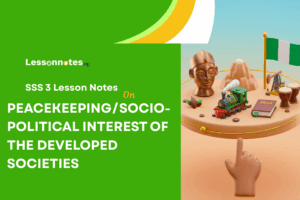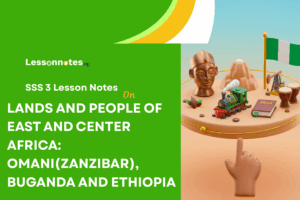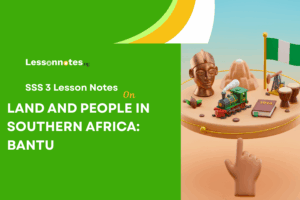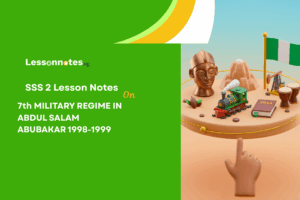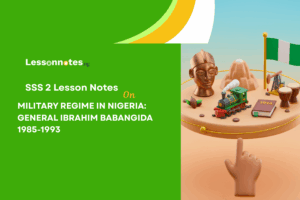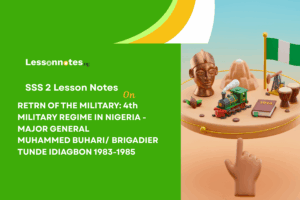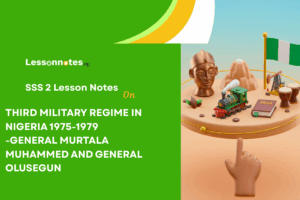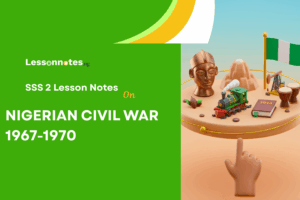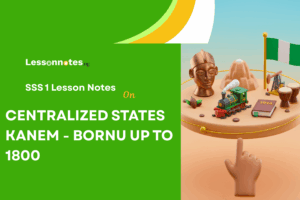Lands And People Of North Africa, Egypt, And The Maghreb SS3 Nigerian History Lesson Note
Download Lesson NoteTopic: Lands And People Of North Africa, Egypt, And The Maghreb
North Africa is the northernmost region of the African continent. It is separated from Europe by the Mediterranean Sea and from the rest of Africa by the vast Sahara Desert. This region includes Egypt and the area known as the Maghreb. The people who live here have rich histories, diverse cultures, and have adapted to life in some challenging environments. In this lesson, we will learn about the lands, the people, and the cultures of North Africa.
The Geography of North Africa
Location and Countries
North Africa includes these countries:
- Egypt
- Libya
- Tunisia
- Algeria
- Morocco
- Western Sahara (disputed territory)
- Sudan (sometimes included in North Africa)
- Mauritania (sometimes included in North Africa)
The term “Maghreb” specifically refers to the western part of North Africa, including Morocco, Algeria, Tunisia, and sometimes Libya and Mauritania. The word “Maghreb” means “west” or “place of sunset” in Arabic.
Major Geographical Features
The Mediterranean Coast
- Stretches from Egypt to Morocco
- Has a mild, pleasant climate called “Mediterranean climate”
- Rainy winters and warm, dry summers
- Fertile land good for growing olives, grapes, citrus fruits, and wheat
- Many important cities are located along the coast
The Sahara Desert
- World’s largest hot desert, covering most of North Africa
- Very harsh environment with extreme temperatures
- Little rainfall (less than 25cm or 10 inches per year)
- Rocky plateaus, vast sand seas (ergs), and gravel plains
- Oases (small fertile areas) where underground water reaches the surface
The Nile River and Valley
- World’s longest river, flowing through Egypt
- Created a fertile valley in the middle of the desert
- Yearly floods (before modern dams were built) brought rich soil
- Made agriculture possible in Egypt for thousands of years
- Most of Egypt’s population lives near the Nile
The Atlas Mountains
- Mountain range running through Morocco, Algeria, and Tunisia
- Highest peak is Mount Toubkal in Morocco (4,167 meters or 13,671 feet)
- Creates a barrier between the Mediterranean region and the Sahara
- Receives more rainfall than surrounding areas
- Home to forests, wildlife, and mountain villages
Other Important Features
- The Nile Delta: Fertile triangle of land where the Nile River meets the Mediterranean
- The Red Sea: Borders Egypt to the east
- The Qattara Depression: A large lowland in Egypt below sea level
- Chott el Jerid: A large salt lake in Tunisia
Climate
North Africa has several climate zones:
- Mediterranean Climate: Along the coast – mild, rainy winters and hot, dry summers
- Desert Climate: In the Sahara – very hot days, cold nights, very little rain
- Semi-arid Climate: Between the coast and desert – some rainfall, but not enough for many crops
- Highland Climate: In the Atlas Mountains – cooler temperatures, more rainfall, snow in winter
The People of North Africa
Population and Demographics
- Total population of North Africa: Approximately 195 million people
- Most populous country: Egypt (over 100 million people)
- Most people live in cities along the coast or near water sources
- Young population with high growth rates in many countries
- Increasing urbanization as people move from rural areas to cities
Ethnic Groups
North Africa is home to various ethnic groups:
Arabs
- Largest ethnic group in North Africa
- Spread throughout the region during the Islamic conquests (7th century CE)
- Share Arabic language and Islamic culture
- Many are a mix of Arab and indigenous Berber ancestry
Berbers (Amazigh)
- Indigenous people of North Africa
- Have lived in the region for thousands of years
- Various Berber groups with different dialects and customs
- Mainly in Morocco, Algeria, and parts of Libya and Tunisia
- Known for distinctive art, music, and cultural traditions
- Many maintain their language and identity despite centuries of Arab influence
Other Groups
- Nubians: Indigenous people living along the Nile in southern Egypt and Sudan
- Tuareg: Berber people adapted to desert life, known as “Blue People” for their indigo-dyed clothing
- Beja: Cushitic people in eastern Sudan and Egypt
- Europeans: Small communities from colonial times, mainly in larger cities
- Sub-Saharan Africans: Communities throughout the region, especially in southern areas
Languages
Several languages are spoken in North Africa:
Arabic
- Official language in all North African countries
- Different Arabic dialects are spoken in different regions
- Egyptian Arabic is widely understood due to Egyptian movies and TV shows
Berber Languages
- Tamazight (standardized Berber language) is official in Morocco and Algeria
- Many different Berber dialects are spoken, including:
- Kabyle (in Algeria)
- Tashelhit (in Morocco)
- Tarifit (in Morocco)
- Tuareg (in desert regions)
European Languages
- French is widely spoken in Morocco, Algeria, and Tunisia due to colonial history
- English is increasingly important, especially in business and tourism
- Spanish is spoken in northern Morocco
Religions
Islam
- Dominant religion throughout North Africa (over 90% of the population)
- Majority are Sunni Muslims
- Important Islamic scholars and centers of learning in the region
- Religious practices influence daily life, art, architecture, and laws
Christianity
- Small Christian communities, mainly in Egypt
- Coptic Orthodox Church in Egypt dates back to early Christianity
- Other small Christian denominations throughout the region
- Some European Christians in major cities
Judaism
- Historic Jewish communities throughout North Africa
- Most Jews left after the creation of Israel in 1948
- Small remaining communities in Morocco and Tunisia
- Many synagogues and Jewish quarters remain as cultural heritage
Historical Overview
Ancient Civilizations
- Ancient Egypt (3100-332 BCE): One of the world’s oldest civilizations along the Nile
- Carthage (814-146 BCE): Powerful maritime civilization in modern Tunisia
- Numidia: Ancient Berber kingdom in parts of modern Algeria and Tunisia
- Mauretania: Ancient Berber kingdom in modern Morocco and western Algeria
Greek and Roman Period
- Alexander the Great conquered Egypt (332 BCE)
- Romans defeated Carthage and controlled North Africa (146 BCE)
- Region became Rome’s breadbasket, producing grain for the empire
- Many impressive Roman ruins remain (Leptis Magna in Libya, Timgad in Algeria, etc.)
Islamic Conquest and Civilization
- Arabs conquered North Africa in the 7th century CE
- Spread of Islam and Arabic language
- Establishment of great Islamic dynasties:
- Fatimids
- Almoravids
- Almohads
- Marinids
- Hafsids
- Mamluks
Ottoman Rule
- Ottoman Turks controlled much of North Africa from 16th to 19th centuries
- Local governors often ruled with considerable independence
- Decline of Ottoman power in the 19th century
European Colonization
- France conquered Algeria (1830) and established protectorates over Tunisia (1881) and Morocco (1912)
- Italy colonized Libya (1911)
- Britain occupied Egypt (1882)
- Colonial period brought major changes to society, economy, and culture
Independence and Modern Era
- Egypt gained independence in 1922 (fully in 1952)
- Libya became independent in 1951
- Morocco and Tunisia gained independence in 1956
- Algeria won independence after a long war (1962)
- Countries have faced challenges of development, governance, and regional tensions
Culture and Society
Traditional Lifestyles
Urban Life
- Cities have been centers of trade, learning, and culture for centuries
- Traditional medinas (old cities) with narrow streets, markets, and courtyards
- Extended family households in traditional neighborhoods
- Modern cities now have both traditional and contemporary areas
Rural Life
- Farming communities in fertile coastal regions and mountain valleys
- Growing olives, grains, fruits, and vegetables
- Traditional village architecture using local materials
- Strong community ties and customs
Desert Life
- Nomadic and semi-nomadic groups adapted to desert conditions
- Following seasonal patterns for water and grazing
- Trading and transport traditions using camels
- Oasis communities combining agriculture and trade
Food and Cuisine
North African cuisine is known for its flavors and variety:
- Couscous: Small grains of semolina, steamed and served with vegetables and meat
- Tagine: Slow-cooked stew named after the cone-shaped pot it’s cooked in
- Bread: Essential part of every meal, many varieties
- Mint Tea: Symbol of hospitality, especially in Morocco
- Spices: Including cumin, coriander, cinnamon, and saffron
- Olive Oil: Used extensively in cooking
- Dates, Figs, and Nuts: Important traditional foods
Art and Architecture
Traditional Architecture
- Islamic Architecture: Mosques, madrasas (schools), and palaces with domes, arches, and minarets
- Ancient Egyptian Monuments: Pyramids, temples, and tombs
- Berber Architecture: Ksars (fortified villages) and kasbahs (fortresses)
- Colonial Architecture: European-style buildings from the colonial period
Arts and Crafts
- Carpet Weaving: Distinctive patterns and techniques in different regions
- Pottery and Ceramics: Decorated with traditional patterns
- Metalwork: Brass and silver items, often with intricate designs
- Leatherwork: Especially famous in Morocco
- Mosaics: Dating back to Roman times, still practiced today
Modern Challenges and Changes
Economic Challenges
- High unemployment, especially among young people
- Dependence on natural resources (oil in Algeria and Libya, phosphates in Morocco)
- Tourism important but vulnerable to political instability
- Agricultural challenges due to climate change and water scarcity
Political and Social Issues
- Balance between traditional values and modernization
- Women’s rights and changing gender roles
- Democratic reforms and governance challenges
- Migration issues (both as source and transit countries)
Environmental Concerns
- Desertification and loss of agricultural land
- Water scarcity becoming more severe
- Coastal erosion and pollution
- Climate change impacts on agriculture and settlements
Country Profiles
Egypt
- Capital: Cairo (one of Africa’s largest cities)
- Population: Over 100 million
- Key Features: Nile River, Pyramids, Ancient history
- Economy: Tourism, Suez Canal, agriculture, services
- Famous Sites: Pyramids of Giza, Luxor, Alexandria, Sinai Peninsula
Morocco
- Capital: Rabat (largest city is Casablanca)
- Population: About 37 million
- Key Features: Atlas Mountains, diverse landscapes
- Economy: Agriculture, phosphates, tourism, manufacturing
- Famous Sites: Marrakech, Fes, Chefchaouen (Blue City), Sahara Desert
Algeria
- Capital: Algiers
- Population: About 44 million
- Key Features: Largest country in Africa by land area
- Economy: Oil and gas, agriculture
- Famous Sites: Casbah of Algiers, Timgad Roman ruins, Hoggar Mountains
Tunisia
- Capital: Tunis
- Population: About 12 million
- Key Features: Smallest country in North Africa
- Economy: Tourism, agriculture, manufacturing
- Famous Sites: Carthage ruins, Djerba Island, El Jem amphitheater
Libya
- Capital: Tripoli
- Population: About 7 million
- Key Features: Mostly desert, oil-rich
- Economy: Oil and gas
- Famous Sites: Leptis Magna (Roman ruins), Ghadames (desert town), Cyrene (Greek ruins)
Conclusion
North Africa, Egypt, and the Maghreb form a region of great diversity and rich heritage. From the fertile Nile Valley to the vast Sahara, from ancient civilizations to modern nations, this region has played an important role in world history. The blend of Arab, Berber, and other cultures has created unique societies that continue to evolve today. Despite facing many challenges, the peoples of North Africa maintain strong cultural identities while also adapting to a changing world.
Evaluation
- Name the countries that make up North Africa and explain which ones are part of the Maghreb.
- Describe three major geographical features of North Africa and how they affect people’s lives.
- Explain the difference between Arabs and Berbers and where they live in North Africa.
- Describe three important historical periods in North Africa’s history.
- What are three challenges facing North African countries today?
Classwork
Answer the following questions:
- What are the main geographical features of North Africa?
- Identify the major ethnic groups in North Africa and their distributions.
- How has geography influenced the way people live in different parts of North Africa?
- Name three important cultural aspects of North African societies.
- Compare life in the Mediterranean coastal regions with life in the Sahara Desert regions.


